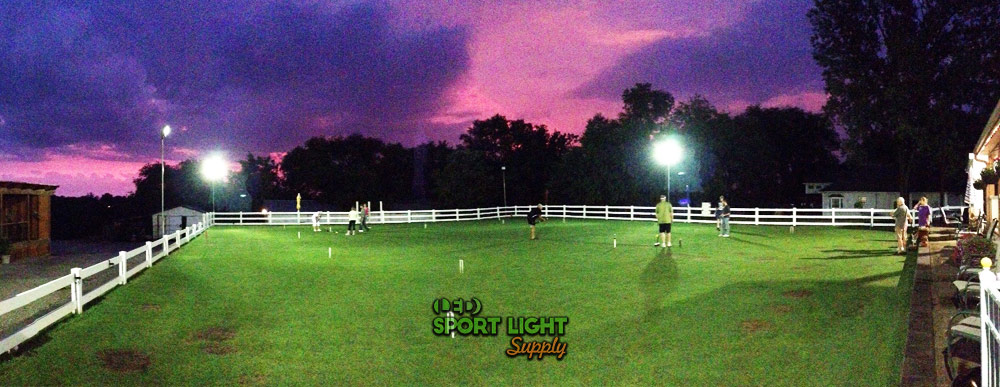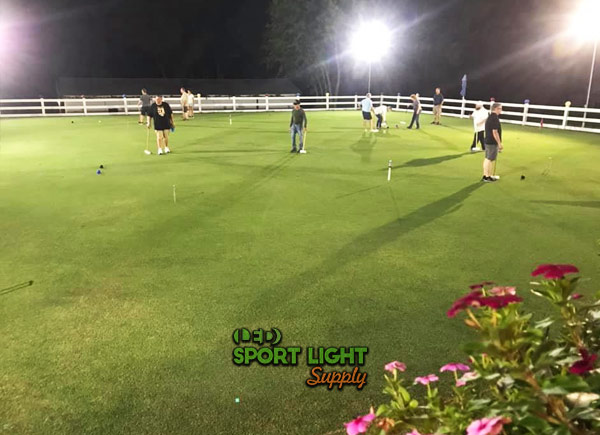Croquet is a sport that brings people of all ages together on the croquet lawn to enjoy their leisure time. While it is a game characterized by precise rules and a competitive spirit, the quality of lighting can significantly enhance the players’ experience. Proper lighting design not only improves enjoyment but also ensures adherence to lighting standards.
The cost of installing and operating an illuminated croquet facility varies based on the type of lights and specific requirements. Additionally, the duration for which the lights are used will affect electricity bills. Ultimately, the key is to select the most efficient croquet court flood lights. To make an informed decision, it’s essential to understand the key factors that influence your overall expenses.
Table of Contents
ToggleFactors Influencing the Cost of Croquet Field Lighting
When it comes to determining the cost of lighting a croquet field, several key factors come into play. The quality of the lighting is crucial, as it impacts both the enjoyment of the game and adherence to standards. Adequate lighting ensures players can see the ball clearly and navigate the field effectively. Here’s an in-depth look at what affects the cost of croquet field lighting:
Croquet Field Size

The size of the croquet field is a primary factor in determining lighting costs. A standard croquet court measures 25.6 by 32 meters, including all boundaries and lines. Larger courts will require additional lights, leading to higher installation and operational costs. If your field exceeds this standard size, you will need to invest in more lighting to ensure proper coverage. If you are uncertain about the number of lights needed, consulting with professionals for precise testing and recommendations based on the exact dimensions of your court is advisable.

Level of Competition
The lighting requirements for croquet vary depending on the level of competition. For recreational play, a lighting level of 150 lux is generally sufficient. However, for competitive matches, a higher illuminance of 500 to 700 lux is recommended. Higher lux levels necessitate higher wattage, which translates into greater energy consumption and cost. For recreational play, especially for older players or casual participants, the focus is on ensuring adequate brightness and even light distribution to facilitate a safe and enjoyable game. Competitive play, on the other hand, demands more intense lighting to meet professional standards.
Light Pole Height
The height of the light poles is another significant factor affecting lighting costs. High mast floodlighting, commonly used in sports facilities, covers large areas but can be costly due to high light loss. For croquet fields, which require more focused lighting, using very tall poles may increase costs as more lights are needed to compensate for light loss. An alternative is to use portable lighting solutions with telescopic light poles, such as light towers. A professional lighting survey can provide a detailed analysis and help determine the most cost-effective solution for your needs.
Light Source Type
The type of light source you choose has a substantial impact on both initial and ongoing costs. Common options include LED, metal halide, halogen, and mercury vapor lamps. LEDs are the most cost-efficient choice, offering lower running and maintenance costs despite a higher initial investment. In contrast, mercury vapor lamps consume more energy and have a shorter lifespan, leading to higher long-term costs. Choosing the right type of light source can significantly influence your overall expenses.
Lighting Uniformity
Uniformity in lighting is crucial for an enjoyable croquet game. Lighting uniformity refers to the consistency of light intensity across the field. High uniformity (typically greater than 0.7) may require additional light sources to eliminate dim spots. Achieving good uniformity enhances gameplay by allowing players to better gauge distances and make accurate shots. While higher uniformity improves the quality of play and spectator experience, it also increases lighting costs due to the need for more fixtures.
Smart Lighting Control System
In addition to technical considerations, the practicality of the lighting control system is important. A smart lighting control system can streamline the management of lighting, making it easier to adjust settings without manual intervention. While this system may come with a higher initial cost, it simplifies operation and can be a valuable investment in the long run. Consider how the smart control system will impact your budget and explore options that align with your specific needs and financial constraints.
Cost of Purchasing Croquet Court Flood Lights
To estimate the cost of purchasing flood lights for a croquet court, it’s essential to determine the total lumen output required based on the field size and the specific lighting standards for your use. Here’s a breakdown of how to calculate the necessary wattage and associated costs:
Calculating Lumen Requirements
The standard croquet field size is 25.6 by 32 meters, totaling 820 square meters. To determine the lumen output needed, you first need to know the lighting standard applicable to your usage. For recreational use, the standard illuminance is 150 lux. To account for light loss, you apply a light loss factor of 1.2.
Lumen Calculation
Lumens required = 150 lux × 820 sq. meters × 1.2 (light loss factor)
Lumens required = 147,600 lumens
Determining Wattage
Next, calculate the wattage needed based on the efficiency of the light fixtures, which is measured in lumens per watt. For example, if a light fixture has an efficiency of 150 lumens per watt:
Wattage Calculation
Wattage required = 147,600 lumens / 150 lumens per watt = 984 watts
For practical purposes, you would round this up to approximately 1000 watts. This total can be distributed across multiple light poles. For instance, if you use four poles with 250W LED lights each, you would meet the required lighting level.
Cost Estimate
The cost of 1000-watt LED lights for a croquet court typically ranges between $800 and $1500 per unit. This price range can vary depending on factors such as brand, quality, and additional features. To get the best deals, it’s advisable to compare prices from different suppliers and consider any bulk purchase discounts or additional costs such as installation and maintenance.
How to Buy Affordable Croquet Court Lights
Finding cost-effective croquet court lights involves several strategies to ensure you get the best value for your investment. Here are some key approaches to help you save money while acquiring the right lighting for your croquet field.
Getting a Photometric Lighting Simulation Report
One of the first steps to take is obtaining a photometric lighting simulation report. Consulting with lighting specialists who use advanced software like DIALux can provide significant savings. This software predicts the precise number of flood lights needed, along with their wattage and beam angles. By optimizing your lighting setup from the start, you avoid unnecessary purchases and ensure efficient use of resources.
The report will not only specify the exact type and placement of lights for your croquet court but also guide you on retrofitting existing systems. Implementing the recommended changes can lead to substantial cost reductions, as it avoids over-specification and ensures you only purchase what is necessary for optimal performance.
Asking for Discounts
Negotiating discounts can be an effective way to reduce costs. Most lighting suppliers are open to offering bulk order discounts, especially if your project involves purchasing multiple lights or related services. Companies are often willing to provide special deals for large orders as a way to secure significant sales and foster ongoing business relationships.
If your project involves extensive installations or multiple units, do not hesitate to inquire about discounts. A simple request can sometimes result in savings, as suppliers are motivated to accommodate larger orders and can offer better pricing structures.
Standardizing Wattage and Beam Angle
Using flood lights with the same wattage and beam angle throughout your croquet court can help reduce both manufacturing and installation costs. When electricians work with uniform equipment, the installation process becomes more straightforward and less time-consuming. This consistency not only simplifies the setup but also minimizes the potential for errors or complications.
Although it may require initial research or expert advice to determine the best configuration, the effort can pay off by streamlining the entire process. If you are able to manage the setup yourself, focus on finding reputable suppliers and ensure you order the correct specifications for your needs.
Opting for LED Lights
LED lights are the most cost-effective option compared to other light sources. They offer an impressive lifespan of over 150,000 hours and significantly reduce maintenance costs due to their durability and efficiency. When replacing older bulbs, look for LED lights that match the lumen output of your existing fixtures. This approach ensures you maintain the same level of brightness while benefiting from lower energy consumption and reduced long-term expenses.
Investing in LED technology is a strategic decision that will provide ongoing savings and enhance the quality of lighting for your croquet court. The initial investment in LED lights will be offset by their longevity and minimal upkeep requirements, making them a smart choice for both budget-conscious and performance-driven projects.
Running Costs of Croquet Lighting Fixtures
Understanding the running costs of different lighting fixtures is crucial for budget planning. Here’s a comparison of the running costs for LED and halogen lights, based on 5 hours of usage per day.
Running Costs of LED Lights
| Fixture Type | Daily Cost | Monthly Cost | Annual Cost |
|---|---|---|---|
| 1,000-watt LED | $0.5 | $15 | $180 |
Running Costs of Halogen Lights
| Fixture Type | Daily Cost | Monthly Cost | Annual Cost |
|---|---|---|---|
| 10,000-watt Halogen | $5 | $150 | $1,800 |
From the comparison, LED lights are significantly more cost-effective. The annual running cost of halogen lamps is ten times higher than that of LED lights. Additionally, halogen lights have a shorter lifespan, which further increases the total cost due to more frequent replacements.
Installation Cost of Croquet Court Flood Lights
When estimating the installation costs for croquet court flood lights, it is essential to factor in various variables. Here’s a simplified approach to calculating these costs using a formula and a table to provide a clearer picture.
Estimating Installation Costs
To estimate the installation cost, use the following formula:
Installation Cost = Lamp Price × 0.3 to 0.9
Example Calculation
Assuming a lamp price of $1,000, the estimated installation costs would be:
| Lamp Price | Minimum Installation Cost (0.3 × Lamp Price) | Maximum Installation Cost (0.9 × Lamp Price) |
|---|---|---|
| $1,000 | $300 | $900 |
So, for a lamp priced at $1,000, the installation cost could range from $300 to $900, depending on factors such as labor location, light pole height, number of poles, and types of lights.
Planning Ahead
Ensure to allocate a portion of your budget for installation or retrofitting. By understanding these costs and getting detailed estimates or free quotes from service providers, you can effectively plan and manage your overall budget.
Conclusion
The costs associated with running and installing croquet field flood lights can add up significantly. However, with careful planning, you can manage these expenses effectively.
Start by measuring the dimensions of your croquet field if you are unsure of its size. Consider any competitions you plan to host, as this will influence your lighting needs. Take into account all factors discussed earlier, such as lighting standards, fixture types, and installation requirements.
